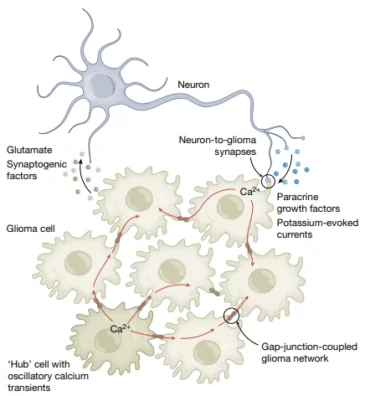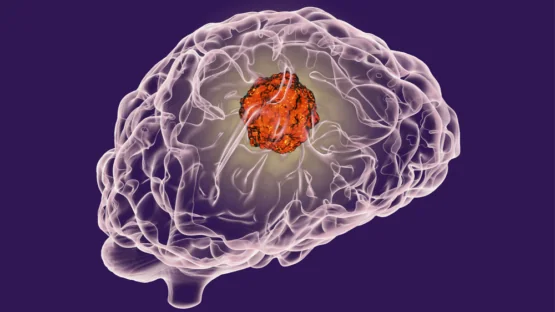A review article published in Nature has outlined the current research into how the nervous system’s signals affect cancer growth.
A surprising connection
This review opens with a bold but heavily documented claim: the central nervous system (CNS) affects various cancers through signaling mechanisms, even those that nominally have nothing to do with the CNS itself. Conversely, cancers send their own signals back to the CNS and affect how it functions. In total, this review cites nearly two hundred papers that document this phenomenon in various forms.
Neurons talk to cancerous glia cells
The first cancer addressed in this review is the most common form of brain cancer, glioma. A glioma consists of multiple types of non-neuron brain cells that originate from cancerous stem cells [1]. In the first stages of human brain growth, the neural signals themselves guide and control this process, sending developing neurons to where they need to go and giving the brain its capacity for later learning and development. Throughout life, neural signals also inform helper glia cells on where to make myelin, the protective sheath around neurons [2].
Gliomas hijack this process. Like normally functioning glial cells, they send and receive signals to neurons; unlike those cells, they use these signals to facilitate their own cancerous growth, as directly confirmed in mouse models [3]. Sometimes, even basic functions like seeing or smelling encourage gliomas to grow in the areas responsible for these senses [4, 5]. The voltage gradient provided by the neurons’ electrical activity, in the form of calcium channels, has been demonstrated to strongly contribute to cancer growth [6].

Gliomas send signals to neurons in the same way, which accounts for the hyperexcitability of neurons in the area and contributes to the seizures frequently seen in brain cancer patients [7]. In human beings, glioma cells secrete a factor that encourages neurons to develop more synapses, remodeling brain structures in a way that causes widespread overactivation of neurons [8]. The cancer has hijacked the brain to fuel itself.
Not just the brain
Cancers outside the brain have also been found to talk to CNS structures. In gastric cancer, the cancerous cells behave similarly to cancerous glial cells. Here, there is a deadly feedback loop, as the CNS sends signals that encourage the cancer to promote further nervous growth and activity [9]. The prostate has been found to be similar, as nervous activity there also contributes to the growth of cancer [10].
Similar relationships were found in the breast [11] and the pancreas [12]. The immune system itself is directly affected by chemical signals, such as serotonin, coming from the brain [13].
A potential for therapies
While a connection between the CNS and cancer seems extremely promising for the development of therapies, it doesn’t mean that it is possible for someone to effectively will away a cancer through sending the right signals. It does, however, open up a wide variety of potential treatments that may have been overlooked, including drugs that affect the CNS and drugs that are normally prescribed only for psychiatric problems. The researchers note that while such drugs might not be sufficient on their own, they might become crucial parts of combination treatments for currently untreatable cancers.
The incidence of cancer rises sharply with age, and we look forward to future research that shows how age-related changes to the nervous system affect the progression of cancer.
Literature
[1] Liu, C., Sage, J. C., Miller, M. R., Verhaak, R. G., Hippenmeyer, S., Vogel, H., … & Zong, H. (2011). Mosaic analysis with double markers reveals tumor cell of origin in glioma. Cell, 146(2), 209-221.
[2] Gibson, E. M., Purger, D., Mount, C. W., Goldstein, A. K., Lin, G. L., Wood, L. S., … & Monje, M. (2014). Neuronal activity promotes oligodendrogenesis and adaptive myelination in the mammalian brain. Science, 344(6183), 1252304.
[3] Venkatesh, H. S., Johung, T. B., Caretti, V., Noll, A., Tang, Y., Nagaraja, S., … & Monje, M. (2015). Neuronal activity promotes glioma growth through neuroligin-3 secretion. Cell, 161(4), 803-816.
[4] Pan, Y., Hysinger, J. D., Barron, T., Schindler, N. F., Cobb, O., Guo, X., … & Gutmann, D. H. (2021). NF1 mutation drives neuronal activity-dependent initiation of optic glioma. Nature, 594(7862), 277-282.
[5] Chen, P., Wang, W., Liu, R., Lyu, J., Zhang, L., Li, B., … & Liu, C. (2022). Olfactory sensory experience regulates gliomagenesis via neuronal IGF1. Nature, 606(7914), 550-556.
[6] Hausmann, D., Hoffmann, D. C., Venkataramani, V., Jung, E., Horschitz, S., Tetzlaff, S. K., … & Winkler, F. (2023). Autonomous rhythmic activity in glioma networks drives brain tumour growth. Nature, 613(7942), 179-186.
[7] Hatcher, A., Yu, K., Meyer, J., Aiba, I., Deneen, B., & Noebels, J. L. (2020). Pathogenesis of peritumoral hyperexcitability in an immunocompetent CRISPR-based glioblastoma model. The Journal of clinical investigation, 130(5), 2286-2300.
[8] Krishna, S., Choudhury, A., Keough, M. B., Seo, K., Ni, L., Kakaizada, S., … & Hervey-Jumper, S. L. (2023). Glioblastoma remodelling of human neural circuits decreases survival. Nature, 1-9.
[9] Hayakawa, Y., Sakitani, K., Konishi, M., Asfaha, S., Niikura, R., Tomita, H., … & Wang, T. C. (2017). Nerve growth factor promotes gastric tumorigenesis through aberrant cholinergic signaling. Cancer cell, 31(1), 21-34.
[10] Bauman, J., & McVary, K. (2013). Autonomic nerve development contributes to prostate cancer progression. Asian Journal of Andrology, 15(6), 713.
[11] Huang, D., Su, S., Cui, X., Shen, X., Zeng, Y., Wu, W., … & Ouyang, N. (2014). Nerve fibers in breast cancer tissues indicate aggressive tumor progression. Medicine, 93(27).
[12] Saloman, J. L., Albers, K. M., Li, D., Hartman, D. J., Crawford, H. C., Muha, E. A., … & Davis, B. M. (2016). Ablation of sensory neurons in a genetic model of pancreatic ductal adenocarcinoma slows initiation and progression of cancer. Proceedings of the National Academy of Sciences, 113(11), 3078-3083.
[13] Huang, S., Ziegler, C. G., Austin, J., Mannoun, N., Vukovic, M., Ordovas-Montanes, J., … & von Andrian, U. H. (2021). Lymph nodes are innervated by a unique population of sensory neurons with immunomodulatory potential. Cell, 184(2), 441-459.



